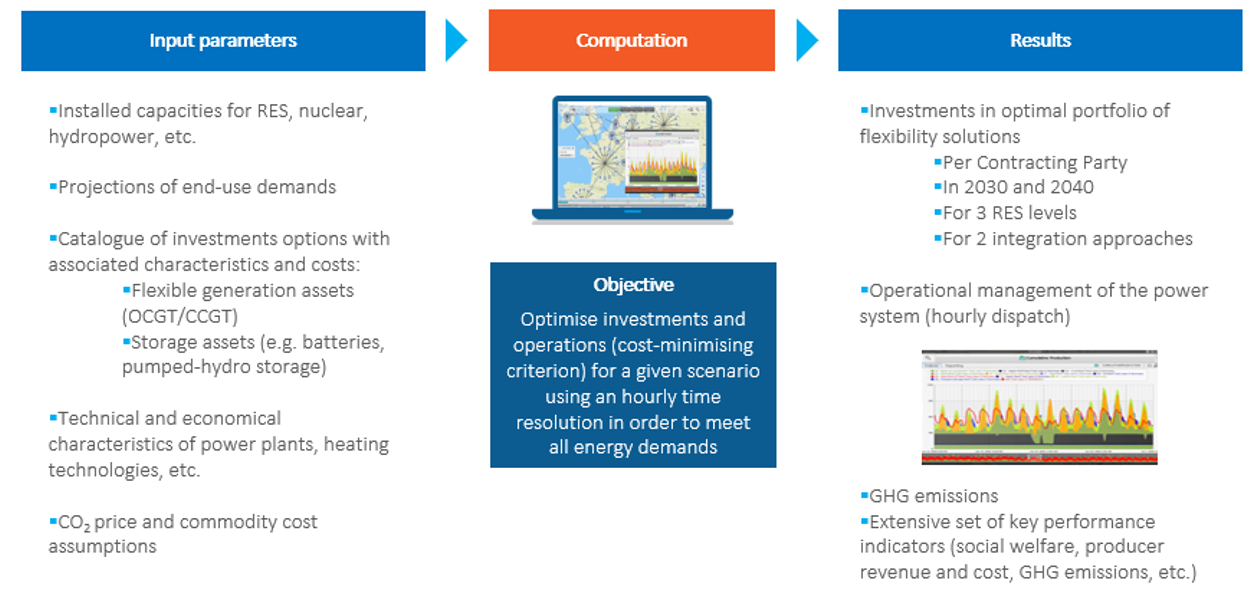High penetration of variable RES is possible in the Contracting Parties of the Energy Community without additional investments into flexibility sources but via increased market integration
In this study, future flexibility needs are evaluated and cost-optimal portfolios of flexibility solutions are determined at the 2030- and 2040-time horizon. A wide range of scenarios are considered, varying in terms of variable RES deployment, phase-out of coal-fired power generation and levels of cross-border interconnection capacity. The scenarios required an extensive data collection and were built in coordination with the Contracting Parties.
Modelling a cost-optimal flexibility portfolio
In order to determine the cost-optimal flexibility portfolios for each Contracting Party (CP), the European energy system model Artelys Crystal Super Grid was extended to Ukraine and Moldova. The modelling exercise was performed via a joint capacity and dispatch optimization of the flexibility portfolios for the different scenarios, with an hourly time resolution and a national granularity.

Eight CPs (Albania, Bosnia and Herzegovina, Kosovo, Moldova, Montenegro, North Macedonia, Serbia, Ukraine) were jointly modelled with the EU Member States, whereas Georgia was modelled independently as an electric island with partial interconnection with neighboring countries.
Two levels of cross-border exchange capacities were considered in this study, reflecting two market integration scenarios. One approach restricts the utilization of NTC capacities to the values observed in the past, whereas the other one makes available at least 70% of the nominal transmission capacities for trading purposes.
The optimal flexibility solutions in the Contracting Parties in 2030 and 2040
A major conclusion from the modelling is that there is no need for investments in additional flexibility capacities by 2030. The existing capacities that provide system flexibility can cope with the rising flexibility needs related to an increasing degree of RES deployment as envisioned by the Contracting Parties, even in a scenario where RES deployment is ambitious, reaching up to 30 GW.
Necessary investments in new flexible solutions are low even in 2040, despite the coal and lignite phase-out envisioned in almost all CPs. Interconnection capacities are the main provider of flexibility at the CP level, allowing to mutualise flexibility resources among CPs and with EU Member States.
Market integration of regional power systems decreases the need for investments in flexibility solutions and drives down CO2 emissions. Such regional cooperation facilitates RES integration at lower costs and reduces congestions between CPs and with neighbouring interconnected countries.
The vision of the Director of the Energy Community Secretariat
Based on the analysis, the Director of the Energy Community Secretariat, Artur Lorkowski, came to the conclusion: “The energy transition is irreversible and today’s study shows that nothing should stand in the way of more renewables. Against the background of the energy crisis, we must look for cost-effective solutions to unlock higher renewables potential. Further electricity market integration is the clear way forward.”
The report is available here!

Artelys Knitro 15.0: New Tools for Your Large-Scale Models
Artelys is pleased to announce the release of Knitro 15.0, which provides new algorithms and performance improvements to solve your large-scale optimisation problems, whether linear or non-linear, more quickly.

Artelys Introduces Future Sight: a Visualisation Tool Supporting the Energy Transition
As partner in the European Climate + Energy Modeling Forum (ECEMF) – a Horizon 2020 Europe project uniting research institutes and leading energy modellers in Europe – Artelys has contributed to modeling activities powered by Artelys Crystal Super Grid modelisation tool, and has led the development of a fully-fledged visualisation tool.

Supercharging Optimisation: How Artelys, FICO and NVIDIA cuOpt Join Efforts to Scale Up Energy System Optimisation
As energy system models continue to scale—reaching up to hundreds of millions of variables and constraints—traditional CPU-based optimisation solvers are hitting performance and memory bottlenecks. These increasingly complex models are essential for planning Europe’s energy transition, yet solving them within realistic timeframes has become a pressing challenge.

Artelys is powering SEleNe CC’s Common Grid Model (CGM) Service
Artelys provides maintenance and support services of the calculation module used to perform the European Merging Function (EMF) at SEleNe CC
subscribe to our newsletters
© ARTELYS document.write(new Date().getFullYear()); • All rights reserved • Legal mentions